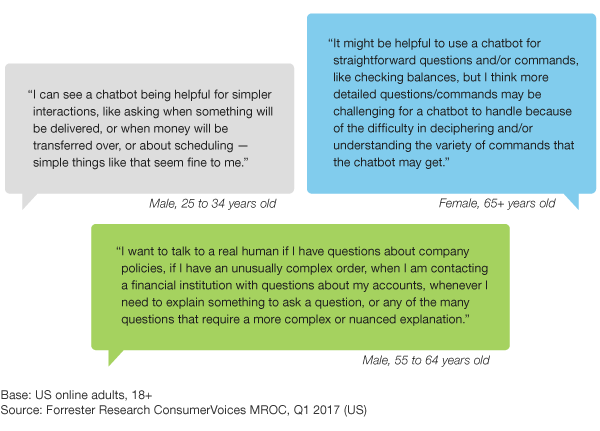The Data Digest: Chatbots Can’t Fully Replace Humans Just Yet
Customer service departments in all industries are increasing their use of chatbots, and we will see usage rise even higher in the next year as companies continue to pilot or launch their own versions of the rule-based digital assistant. What are chatbots? Forrester defines them as autonomous applications that help users complete tasks through conversation.
While Forrester’s Consumer Technographics® data reveals that 60% of US online adults already use online messaging, voice, or video chat services, there are challenges to widespread adoption. We reached out to our ConsumerVoices Market Research Online Community members to better understand consumer impressions of chatbots and found that our respondents had a difficult time identifying clear benefits to interacting with them. Many prefer to communicate with a representative who can show real empathy, address more complex needs, and offer them assurance.

Earlier this month, I attended the Qual360 2017 conference in Washington, D.C., where chatbots were a hot topic in both qualitative research and customer experience. Speakers highlighted the opportunity of chatbots while warning about their shortcomings. For example:
- Paul Hudson of FlexMR and Tom de Ruyck of InSites Consulting focused on how chatbots are very capable of capturing large amounts of information and addressing simple needs, using rule-based logic and natural language processing capabilities.
- Ross McLean of Over The Shoulder noted that chatbots are unable to truly empathize with the respondent or customer – while they can mimic human empathy, they can’t pick up on nuances in conversation that fall outside their rule-based logic.
This leads me to a few points of guidance for businesses considering launching chatbot services:
- Tell your customers that they’re speaking to a chatbot and what its limitations are. A big barrier to customers using chatbots is that customers need to know if the bot will be able to meet their specific need. Be specific about what it can and can’t do. This will minimize any negative sentiment or fallout resulting from a feeling of deceit on the part of the moderator or business.
- Ensure that the chatbot can identify when a customer needs to speak to a live representative as early as possible — and make the transfer seamless. Provide the live CSR with a transcript of the conversation with the bot to minimize any need for the customer to repeat information. This will best ensure that the customer has a great customer experience – in terms of ease of use (and speed of resolution), effectiveness in meeting their needs, and generating an overall positive emotional sentiment.
Not a Technographics client and interested in accessing qualitative consumer insights and social trends? Contact us at data@forrester.com.
Kristopher Arcand is a data analyst focusing on qualitative insights. Follow him on Twitter at @kristophersays.